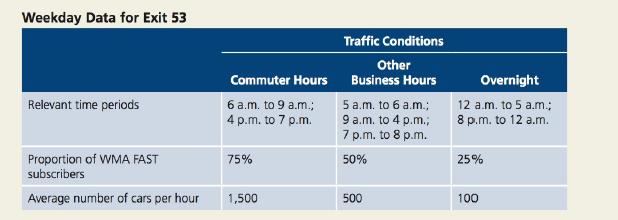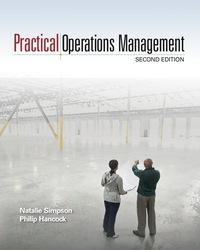Western Motorway Authority (WMA) operates a network of toll roads connecting three urbanized areas. Each of its
Question:
Western Motorway Authority (WMA) operates a network of toll roads connecting three urbanized areas. Each of its toll collection plazas offers a choice of payment methods to approaching drivers, including WMA FAST, a subscription service that allows drivers to pay wire- lessly as they pass through a special toll lane without stopping. Exit 53 Toll Plaza is a typical WMA facility, equipped with five toll lanes, including one dedicated to WMA FAST subscribers only. The remain- ing four lanes are equipped with booths from which WMA attendants collect tolls manually, known as cash lanes even though attendants can process credit and debit card payments for an additional fee. Since exit 53 is the end point of a long commuter route into a city center, toll prices are too high at this plaza to make automated coin collection a practical choice, although WMA does use this technology elsewhere. While exit 53 is equipped with five toll lanes, WMA only operates all five lanes during special events. The fully automated WMA FAST lane is always open to arriving subscribers and can process an average of one vehicle every 3 seconds. Attendants in the cash lanes generally average one vehicle every 15 seconds when busy, and WMA usually varies the number of open cash lanes between one and three, depending on traffic con- ditions. During the 24 hours of a typical weekday, exit 53 cycles between three levels of traffic conditions, described in the Weekly Data for Exit 53 table.
Approaching drivers who subscribe to WMA FAST follow brightly colored markers toward their dedicated lane, while the remaining drivers sort themselves evenly into short queues before the open cash lanes. Since frequent users of the toll plaza are more likely to subscribe to WMA FAST, the proportion of subscribers is highest during commute times and lowest overnight. One serious concern for WMA is tailback, or the length of the queue of vehicles that forms in front of a busy cash lane tollbooth. If WMA has too few cash lanes open and the resulting tailback grows long, this creates unsafe congestion in the approach area where drivers slow their vehicles and choose a lane. To maintain a safe approach area, WMA has determined that this fluctuating tailback should not average more than four waiting vehicles per lane. To open a cash lane, WMA must schedule an attendant, who will work a 4-hour shift in that lane. On weekdays, attendants can be scheduled to start work at midnight, 4 a.m., 8 a.m., noon, 4 p.m., or 8 p.m..
Questions
1. Use the M/M/1 model to analyze a typical cash lane at the exit 53 toll plaza. On a weekday, what is the minimum number of cash lanes that need to open during each of the three traffic conditions, to keep average tailback down to four vehicles or less?
2. Now consider the start times and 4-hour shift length of the cash lane attendants. Combine your analysis from the first question with knowledge of these scheduling restrictions to recommend a work schedule for these attendants. How many atten- dants should start work at each of the 4-hour intervals described, to provide at least the minimum number of cash lanes?
3. Consider the probability that an arriving vehicle will find an idle cash lane open at exit 53, and can drive up and pay without waiting. Using your recommended week- day staffing schedule, when is this probability at its highest? When is it at its lowest?
4. Some people in WMA management are concerned over the high cost of WMA FAST lane installations. What is the utilization of the WMA FAST lane installation at exit 53?
Step by Step Answer:






